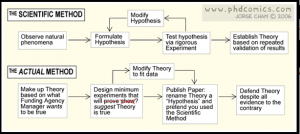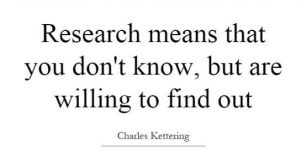
A fun look at the research method by Jorge @ Phd Comics
Research Method is a structured investigation of a specific phenomena with the objective of validating a hypothesis relating to it. It starts with a careful observation of the phenomena – in my case, it started with an observation on the purchasing behavior of the residential sector rooftop solar buyer. Since we wanted to investigate the underlying factors that triggered the purchase intent of the buyer, it had a number of steps that shaped my research learning.
Firstly, I remember very clearly that my guide made me define in writing the profile of my target buyer so that I could focus my research effort appropriately. He felt – and I realized later – that I was leaving a key step loose in the research process. As I defined my target buyer, it focused my research area and literature review decisively.
Literature review helped give a view of the peer perspective of the problem and their approach to researching it. Somewhere on the way, the literature gaps became obvious and started shaping the problem statement and possible approach.
It is relevant to note that your academic institute will have a defined standard for an acceptable PhD work. As explained earlier, the key research philosophy question is ” what is acceptable knowledge”> Typically, the expectation is that the work presented should be empirically positive, objective and quantitatively deductive. For more details on concepts of epistemology and ontology of research – I recommend “Essentials of Business Research” by Jonathan Wilson, Sage.
Once we take the path of a quantitative research, we need to define a valid sample size. Normally, you are looking at 95% confidence and less than 5% error in your research observations. This will mean that you are looking at sample size of ~400. Moreover, if you are doing factor analysis – again depending on the items in your research instrument, you will require to take a sample of at least 400 nos from your sample universe to have an acceptable research observation.
Basis the model that you hypothesize for your research dependent variable, you will have a research questionnaire (refer tip). Your exploratory research will identify relevant items in the questionnaire to retain to improve your Cronbach Alpha ( a measure of instrument reliability) to a minimum value between 0.7 to 1.0.
Once you have got a reliable instrument, and a valid sample size for a clearly defined target audience, you can proceed with the final data collection. In my case, I used an external field agency for data collection. Care was taken to ensure that the field agents were properly trained, the questionnaires had a regional language translation available for backup, ethical considerations were clearly addressed. Audit points and audit trails were built into the instrument and research collection process to get reliable and valid data.
Once the data is ‘in’, in my case, the OMR forms were loaded on a document scanner and we captured the data from over 2000 pages in less than an hour. Also, the OMR software was used to identify errors, missing entries and refined our data extraction – and our effort dramatically. In the end, the data was available by end of the day for the net step in the process – the analysis – this will be covered in a subsequent tip!



2 Responses
AffiliateLabz
Great content! Super high-quality! Keep it up! 🙂
Ashwini Aggarwal
Appreciate your kind words,
Warm Regards
Ashwini